When the S2 launched, Leica announced that the camera would feature a dual shutter system. The rear of the S2 has a power switch with three positions: Off, FPS and CS. FPS stands for focal plane shutter, which is standard in just about every SLR-type camera out there (except the Hasselblad H system). CS stands for central shutter, also commonly referred to as a leaf shutter or a lens shutter. Leica is getting close to launching the CS lenses and I had an opportunity to try them out. Before getting into the tests, let’s take a look at what a dual shutter system offers.
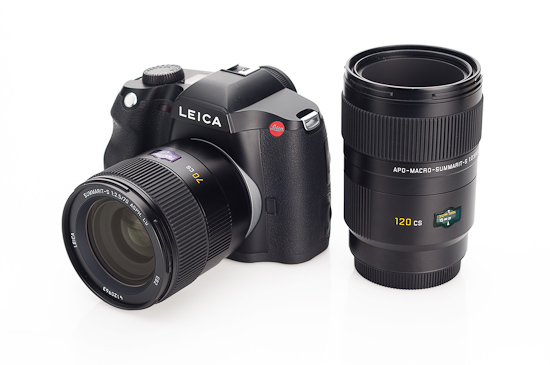
Advantages for focal plane shutters
Found in just about every SLR made, focal plane shutters have the advantage that they can fire at much higher speeds than lens shutters. The S2’s shutter is capable of speeds up to 1/4000th of a second, while leaf shutters are usually limited to 1/500th or 1/800th. This can be an issue if you want to shoot in bright sunny conditions with a very wide aperture. If we suppose that an average daylight exposure is 1/500th @ f/8, ISO 160, then if we want to shoot at f/2.8 we really do need to be able to crank the shutter speed up to 1/4000th. In the case of a Hasselblad H4D, the camera only has a lens shutter that is limited to 1/800th. In order to shoot at f/2.8 in bright sun, you’d have to use a 2 or 3-stop ND filter on your lens. Of course, this also makes the viewfinder very dark and provides a challenge to the autofocus system. Besides being able to shoot at wide apertures for depth of field control, stopping action also becomes an issue if limited to slower shutter speeds. Even the fastest action can be frozen at 1/4000th.
And because the focal plane shutter is in the camera body, lenses from other systems can be adapted given an adequate focal flange distance. The S2 body can easily accept lenses from Pentax 67, Mamiya 645 and Hasselblad V systems by using adapters.
How a focal plane shutter works
A focal plane shutter is comprised of two shutter curtains working in unison. The first curtain opens to expose the sensor, then after a predetermined amount of time, which we call the shutter speed, the rear curtain closes to end the exposure. At slow speeds (slower than 1/125th on the S2) the first curtain is fully open before the second curtain stats to close. At faster speeds (faster than 1/125th on the S2) the second curtain starts to close before the first curtain is fully open. At the fastest speed of 1/400th the space between the curtains is just a horizontal sliver which moves vertically in front of the sensor. The reason for this is that the speed of travel of the curtain is fixed; only the time between first and second curtains affects shutter speed.
Disadvantages for focal plane shutters
The downside of a focal plane shutter is that the flash sync speed is limited. Because a strobe fires a single burst at a very short duration, usually in the neighborhood of 1/3000th of a second, the sensor must be fully exposed when the flash fires. If the second curtain has already started to close in order to get faster shutter speeds, you’ll see a dark line in the resulting image. The fastest speed at which the shutter is fully open is referred to as the X-sync speed. In the case of the S2, this is 1/125th of a second. This isn’t an issue in studio where everything is controlled, but it could be an issue when using battery-powered strobes outside.
A look at central shutters
The central shutter used in Leica CS lenses is comprised of four carbon fiber blades mounted in the center of the lens (kind of obvious looking at the name, I suppose). The optical elements and the light ray bundle passing though them have the smallest diameter at this point, which allows the shutter blades to be as small as possible in order to open and close in the shortest amount of time. As opposed to a focal plane shutter, a central shutter only has one set of blades which open and close in a circular fashion to expose the sensor, mechanically similar to how a lens aperture works. One of the benefits of this approach is that a central shutter is able to sync with a strobe at any shutter speed up to its maximum. In the case of the S2, this is 1/500th of a second, or two stops faster than the focal plane shutter’s X-sync speed.
Besides faster sync speeds, lens shutters also offer lower vibration than focal plane shutters due to less moving mass. In DSLR systems, the mirror is usually the key vibration factor, which is why it is good practice to use mirror lock-up when shooting at slower speeds on a tripod. But, even with mirror lock-up, not all focal plane shutters have the same amount of vibration. The S2’s shutter is extremely well damped. Other cameras like the Pentax 645D…not so much. No amount of mirror lock-up will prevent shutter bounce at speeds like 1/15th.
What about both?
On most camera systems the photographer is usually limited to one shutter system or another. Nikon and Canon DSLRs only offer focal plane shutters. The Hasselblad H system only offers lens shutters. The Leica S2 was designed with the intention of allowing the use of either the built-in focal plane shutter or a central shutter when used with a CS lens. Even more conveniently, there is a quick switch on the back of the camera to select which shutter to fire. And, Leica has added a couple fail-safes to the procedure. If you are set to CS but have no CS lens mounted, the camera will still function in FPS mode with just an on-screen alert to the user. Similarly, if you are shooting in CS mode with a CS lens mounted but set the shutter speed dial faster than 1/500th, the camera will automatically switch into FPS mode. Both are designed to keep the camera from getting in the way of the natural flow of shooting.
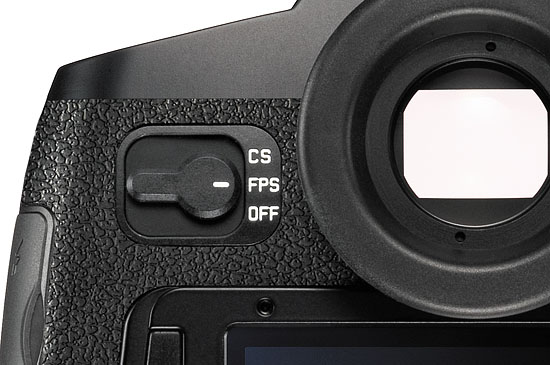
S2 product manager Stephan Shulz explained to me how the S2 works with both shutters. He outlined the firing sequence as follows:
- Shutter release is pressed
- Mirror goes up
- Aperture diaphragm closes down to desired f-stop
- Focal plane shutter opens
- Camera starts exposure electronically
- Central shutter closes
- Aperture opens
- Focal plane shutter closes
- Central shutter opens
- Mirror returns
What’s interesting to note in the sequence is that the exposure starts electronically. This allows for a simpler movement by only having the central shutter close to end the exposure rather than open and close. Mirror blackout time and shutter lag are both minimized, which I found more than acceptable in my own testing.
Leica CS Lenses
The Leica CS lenses are virtually identical to their non-CS lens counterparts. They have exactly the same optical design and the only exterior visual cue is the small white CS letters engraved after the focal length on the lens barrel. Because they have an added shutter mechanism, the CS versions are a couple ounces heavier, but in practice, the added weight is not noticeable.
Not all S lenses will be available in CS versions. The 30mm Elmarit-S, 35mm Summarit-S, 70mm Summarit-S, 120mm APO-Macro-Summarit-S and the 180mm APO-Elmar-S will all be available in CS versions, but upcoming lenses like the 24mm super wide angle and the 30-90mm zoom will only come in non-CS flavors.
CS Lens Upgrade Program
Leica is still offering a CS lens upgrade program for anyone that has purchased a brand new non-CS lens up until the official release of the CS lenses. Essentially, you would only have to pay the difference in price between the non-CS and the CS version, trade-in the old lens, then take delivery of a new CS lens. While we don’t have all the details on how the logistics will work, Leica has been very clear that the upgrade program only applies to first owners who have purchased brand new lenses from an authorized dealer. In other words, used lenses don’t qualify.
Actually shooting with CS lenses
Thanks to our friends from Leica Germany, we were able to get a couple days to test two CS lens prototypes, a 70mm CS and 120mm CS. The lenses, we were told, were QC samples with over 150,000 shutter actuations each.
Without time to organize a full shoot I called up our friend Amy, who was going to be working at an event on Fort Lauderdale Beach with her daughter Alex. Graciously, Alex agreed to do a little impromptu modeling for some casual testing. This was not the usual full-production shoot with assistants and hair/makeup. I kept the equipment simple with a single Profoto AcuteB 600R pack and one head with a Profoto white beauty dish. Triggering was accomplished with a PocketWizard Plus II transceiver on the camera and the built-in receiver on the AcuteB pack.
In this first shot, I wanted to give a reference point with just natural light taken wide-open. Without a focal plane shutter, I wouldn’t have been able to shoot at f/2.5 as there was an abundance of daylight, even on a slightly overcast day.
The next image is what you would get by using a strobe at 1/125th of a second, in other words, without a central shutter. To darken the sky further, you’d have to stop down to f/16 or more. This can be problematic for two reasons: sharpness-robbing diffraction and the need to use a lot of flash power on the battery pack. More power output translates to longer recycle times and reduced battery life.
Now, this is what is easily accomplished with a CS lens at 1/500th. Here, the ambient exposure is actually 1/500th @ f/5.6. By shooting at f/8, I am underexposing the background by one stop, deepening the color and providing a slight amount of pop. As an added benefit, I also am using almost two stops less power on my Profoto pack which equates to 1/4 the amount of power. This allows for much faster recycle times and longer battery life.
For the next shot, I turned the power back up to f/13 but kept the shutter speed at 1/500th. The background is now being underexposed by two and a half stops, making for a pretty dramatic image. The amount of flash power is exactly the same as the shot taken at f/125th above.
Of course, with a high sync speed of 1/500th we can push things a little further. Here, I set the ISO to Pull 80 (lowering the exposure an extra stop) and went one half stop further on the aperture to f/16. The background is now being underexposed by four stops! Overall, the image looks like it was shot at dusk. Almost 100% of the light on Alex is from our strobe. You can actually see that on her left arm there is a shadow. In reality, this is where the sun was hitting her arm. We’ve completely overpowered the sun and stayed away from having to resort to extremely small apertures where quality would have suffered. And, my little 600Ws battery pack with one head was fully up to the task of providing enough light.
Of course, there are in-between settings that don’t have to go to extremes. Here, it’s easy to make a pleasing blend of ambient and strobe by dialing back a little power and shooting at more open apertures, using the higher shutter speed alone to control the background. The use of the 120mm also helps to reduce DOF.
For the last set, I wanted to show what happens when you keep the overall exposure the same but vary the DOF. The first shot is taken at 1/125th @ f/8 to show the result with focal plane shutter only.
The second shot was taken at 1/500th @ f/4 at the same equivalent exposure. I lowered the flash power by two stops to compensate. The result is obviously much smoother and I prefer the overall look.
Conclusion
While my test was somewhat brief, I did appreciate the added flexibility of the higher sync speed on the CS lenses. The additional speed allowed for shallower depth of field and more ambient light control. The marginal increase in weight wasn't noticeable and the additional viewfinder blackout was minimal and not objectionable. For photographers shooting on location with strobes and requiring fast sync speed, the lenses will be an invaluable addition to the S system.

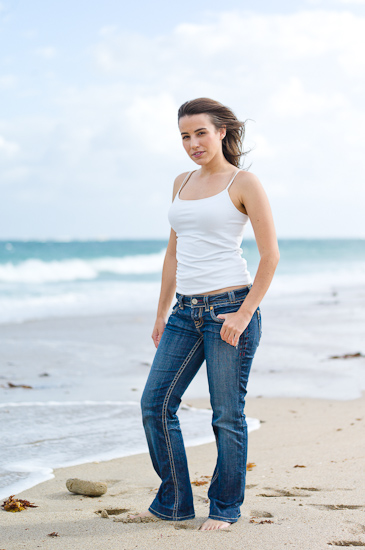
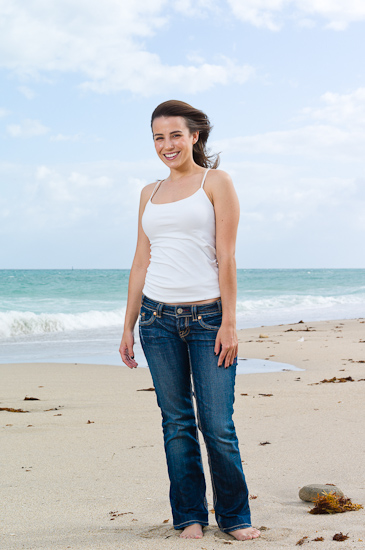
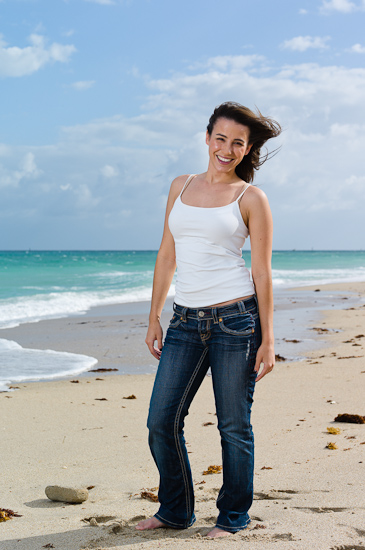
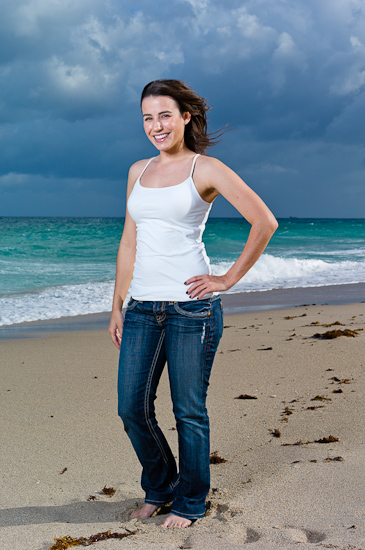
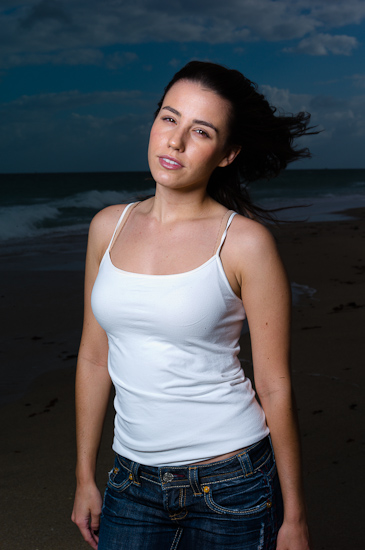
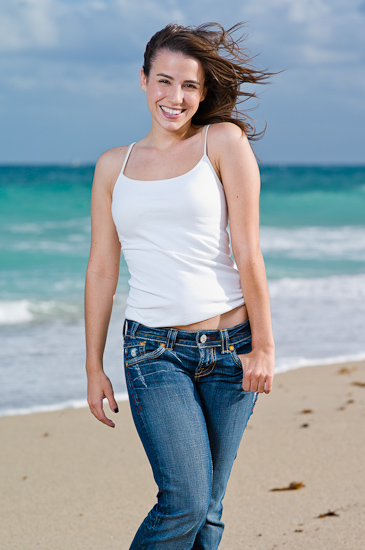
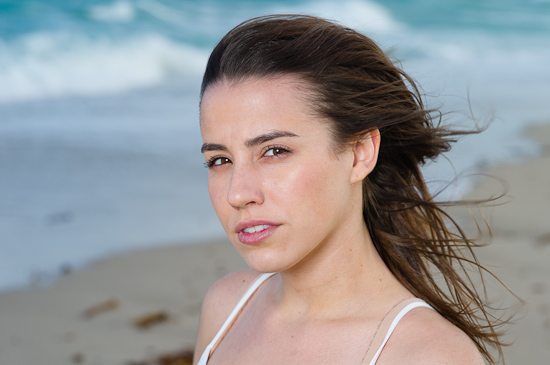
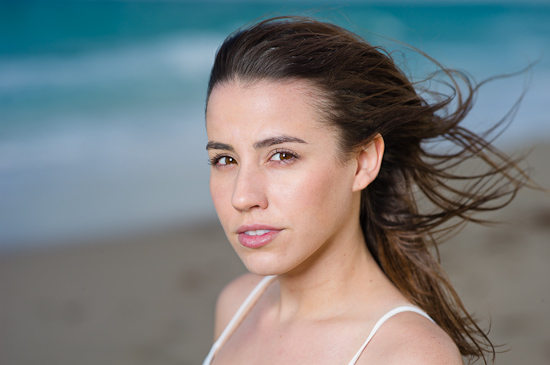
This is a well written and clear explanation of the advantages offered by the CS lenses. I’m going to want the 70mm for sure.
Thanks david for the review.
I did however wonder if you could not have achieved the same effect (shallow DOF in bright light) with a ND filter?
Tom
Tom,
Yes, you could achieve a similar effect with a 2-stop ND filter. The major difference is that an ND filter would influence both the ambient exposure and the flash exposure. The faster sync speed of a CS lens would only impact the ambient exposure. The net effect would be that you would need 4x the amount of flash output when using a 2-stop ND. Also, the viewfinder would be 2 stops darker (same as shooting an f/5.6 lens). This could make AF and composition a bit more challenging.
Tom…interesting question and something that I recently experimented with, i.e. using an ND filter with lights. While I have an ND filter for the S2 for my test I used the Nikon D3S with a Singh Ray Vari-ND filter. While this setup does achieve isolation of the subject due to shallower DOF it’s not without it’s challenges. Foremost among those is focusing since the viewfinder can get quite dark while using them. With the Vari-ND it is possible to turn the filter and brighten up the viewfinder for focusing… then turn it back to the proper setting and take the shot. This slows things down quite a bit and, with the ND kit I have for the S2… it would be even slower. My conclusion is that it works but really isn’t a viable option to the CS lenses. YMMV…
You guys are certainly right, I came from the rangefinder thinking where many Noctilux users have ND filter (I have neither -no noctilux and no nd filter).
But then with a rangefinder the filter does not have any influence on viewfinder an focusing.
I thought about the CS lenses but since I shoot 90% natural light and only occasionaly flash (and if flash so far only the Leica flash and no professional light) I will probably stay with the non cs lenses and save the money and weight.
If it si just for a little fill flash from the leica unit HSS seems to also work fine.
I understand the need for cs lenses for professionals nd first thought to exchange maybe one lens (the 120 or 180).
Good the Leica finally got it working.
Thanks David … I’ve waited very patiently for these CS lenses and will swap at least two of my S lenses for the CS versions and pay the difference as promised by Leica when I bought the camera. The 70mm for sure and probably the 120mm because they are my most used “people” lenses … so it is excellent that those are the two CS lenses that you got to play with : -)
The dual shutter was a major factor in selecting the S system … and the ability to select a higher shutter sync speed has a number of advantages … some of which you have demonstrated here. I currently also shoot with a Hasselblad H4D/60 with all lenses syncing to 1/800th (if hard wired to the strobe, and 1/500th is using a radio transmitter), so am totally aware of the diversity it brings to the party.
Another advantage of higher speed sync is the ability to overpower the ambient indoors … using the opposite of “dragging the shutter techniques” which opens up backgrounds, you can eliminate ambient as a factor in any shot where the background is cluttered and distracting … or use background strobe to balance with the foreground, and totally get rid of ghastly mixed ambient sources.
Very versatile.
I would urge anyone with a S camera to really think through getting the CS versions … this camera is terrific in ambient, however, it absolutely sings with studio lighting and opens up a whole new world of photography. I know many are a bit intimidated by artificial lighting, but it really isn’t that difficult, and just a simple lighting outfit like David was using brings new levels of performance to the S system. I’m currently teaching another S2 user how to work with strobes and he went from a bit skeptical to being amazed by what is possible.
David, while I understand the simplicity of your demo shown here, I think the light was a tad hard and “flashy” feeling on some … which I believe is due to the modifier used. Of interest to many may be the use of some newer modifiers like the Elinchrom 27.5″ or 39″ Deep Octas or Varistar umbrella softbox … both of which set up in seconds for remote location work … and can be used on Elinchrom EL heads or Profoto heads with the EL to Profoto adapter. Very nice natural looking quality of light when either balancing the background or overpowering it.
thanks for the nice report, but …
well, nice to hear that Leica finaly starts producing the CS-lenses. Finally. After all.
But I’m really pi**ed off about the news that the upgrade will not be awailable for used lenses. Why? Because there will be a flood of used non-CS-lenses who come on the market. I could understand Leicas policy if they had, as announced, deliverd CS-lenses from the start with a short delay. But now, after more than two years of waiting, some used lenses were sold with the promise of a possible upgrade. Also, since the start of the Leica S-System, the website of Leica always mentioned the option of an upgrade. Changing this policy afterwards is just unfair.
Also, I already payed the upgrade for my 120 CS-lens when I bought it some months ago, and am still waiting for the upgrade.
To be honest, I’m disapointed about the S-System. In my opinion, the M-System is much better built, and the price more justified. I will test the 800E once I get it and then made a definitive decision.
Personally, I am very satisfied with the S system, and do not think for a minute that a D800 would/could replace it for my work. It is the best designed and built camera I’ve ever owned … and I’ve owned just about everything out there.
I also do not think Leica is an altruistic company that will sacrifice profit margins by allowing sold S lenses to be upgraded. They offered original S2 buyers the upgrade path to CS lenses in order to sell cameras and lenses before the CS lenses could be made. Just like some MFD makers allow you to buy a new back by providing the previous model until the new back is available. It is a sales tactic to either get you into a system, or keep you in a system.
My only gripe is that the S3 will be here before I can get any use of the S2 with the CS lenses. I use strobes a lot, and I bought into the S system to get to the CS lenses … in effect, I paid for a full camera, and got less than a fully functioning one.
-Marc